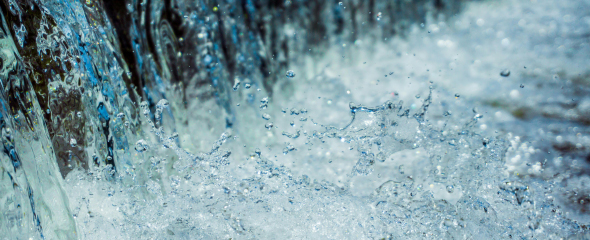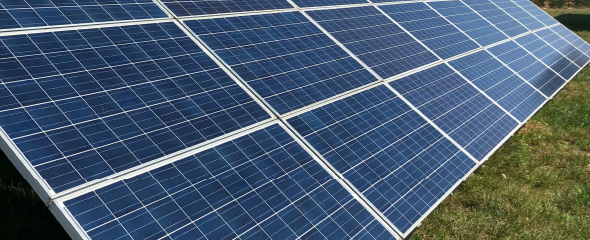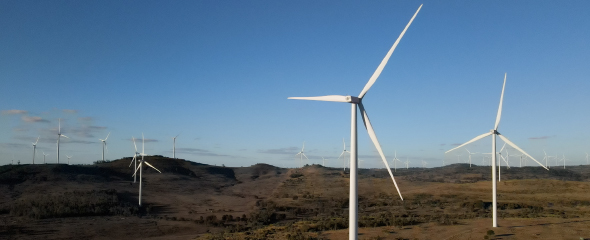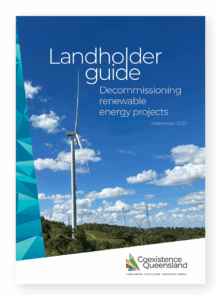On this page
Coexistence Queensland values the collaborative efforts of numerous organisations that play a part in contributing valuable resources which align with our mission of fostering sustainable coexistence between landholders, communities, and the energy and resources industries. We acknowledge and appreciate the resources and information provided, which play a crucial role in informing and supporting our work.
Gas
Extraction of natural gas from wells drilled into underground reservoirs located on land.

The Gas Guide has been specifically collated to deliver landholders a clear and easy to understand guide of what to expect during each stage of engagement with petroleum and gas developments, on private land, in Queensland.
The Queensland Energy Roadmap 2025 outlines how the Queensland Government plans to manage existing energy assets while guiding investment in new generation and storage. It gives a clearer view of how future projects may be planned, coordinated and timed across different regions.
Landholder guide: Negotiating onshore gas activity was developed in partnership with landholders who have firsthand experience negotiating onshore gas agreements, as well as peak bodies and government agencies, to provide independent guidance. The experiences, insights and lessons learnt were crucial to informing this practical guide for those beginning their journey towards sustainable coexistence.
This page explains landholder rights, compensation types, negotiation processes, and agreements, offering guidance for securing equitable outcomes when working with resource companies.
This page outlines dispute resolution options for landholders negotiating land access or Make Good Agreements with resource companies. It provides practical resources, including fact sheets and links to other services to ensure landholders can address challenges constructively and effectively.
This guide has been prepared to assist landholders and resource companies in understanding Queensland’s land access laws as provided in the Mineral and Energy Resources (Common Provisions) Act 2014 and how they relate to the exploration and development of Queensland’s mineral and energy resources on private land.
The Land Access Code sets out best practice guidelines for communicating and negotiating with landholders, and imposes mandatory conditions about conduct when entering and carrying out authorised activities on private land.
GeoResGlobe allows you to find, view and interact with maps, imagery, property, resources and other specialist data.
The Landholder and Community Better Practice Engagement Guide has been designed to assist in the respectful engagement that needs to take place for the design, development, delivery, operation and/or maintenance of new or existing energy assets. In particular, it focusses on the transmission infrastructure associated with energy projects such as transmission lines and gas pipelines.
A Make Good Agreement is a legally binding agreement entered into by a resource tenure holder and a bore owner about a water bore. Use the following factsheets and templates to guide you through the process:
- Make Good Agreements for bore owners
- Make Good Agreement – Process Flow Chart
- Make Good Agreement – Decision Table
- Make Good Agreement Templates – Guidance Notes
- Make Good Agreement Template – No Make Good Measures
- Make Good Agreement Template – Monitoring
- Make Good Agreement Template – Compensation
- Make Good Agreement Template – New Bore(s)
This interactive electricity generation map includes existing facilities together with publicly announced renewable energy projects.
The Queensland Government’s regulatory framework protects landholders, communities and the environment while facilitating the establishment of a sustainable onshore petroleum and gas industry.
Working on the land can affect your health, both physically and mentally. If you or someone you know are in need of support, there are countless services available across numerous platforms (via phone, online, face-to-face).
If you need more information about the resources and energy sectors, check out these links to relevant organisations, research institutions, state and local government departments, private companies and industry peak bodies.
The FAQs page provides clear, concise answers to common questions about Queensland’s onshore gas industry, covering topics such as environmental impacts, landholder rights, dispute resolution, and regulatory frameworks.
The Interactive Gas Map gives you public access to easily view and download geospatial data and information relating to the various Queensland onshore gas industry activities that may be found within or surrounding your local government area.
See examples of the feedback we’ve submitted to government and non-government entities on policy positions that focus on managing and improving the sustainable coexistence of Queensland landholders, rural and regional communities, and the onshore gas sector.
- October 2025 | Energy Roadmap Amendment Bill 2025 Submission
Submission to the Queensland Government on the Energy Roadmap Amendment Bill 2025, with feedback on proposed amendments relating to Regional Energy Hubs and a renewable energy developer Code of Conduct. - November 2023 | Australian Government Future Gas Strategy Consultation Paper
Response to the Australian Government with a focus on the Commission’s experience in facilitating sustainable coexistence between landholders, regional communities and the onshore gas industry. - August 2023 | Lake Eyre Basin Consultation Regulatory Impact Statement
Formal response to the Department of Environment and Science on its regulatory impact statement. The regulatory impact statement focuses on ensuring Queensland’s environmental protections achieve a balance between ecological sustainability and future economic prosperity for the region. - June 2023 | IESC’s Draft Information Guidelines Explanatory Note: Subsidence Associated with Coal Seam Gas Production
General feedback provided to the Independent Expert Scientific Committee (IESC) to ensure the explanatory note was fit for purpose in the context of the Commission stakeholders ability to access and consume the information. - February 2023 | Improving Queensland’s Land Release Process Discussion Paper
Formal response to the Department of Resources’ discussion paper with proposed refinements to the land release process. - February 2023 | A Review of Coexistence Principles and Coexistence Institutions Discussion Paper
Formal response to the Department of Resources’ discussion paper with information relating to the Commission’s experience in the areas of land access and coexistence. - May 2022 | Draft Coal Seam Gas (CSG) Brine Management Action Plan 2022-2032
Formal response with recommendations for the Department of Environment and Science to consider factors that may enhance some elements of the draft plan. - February 2022 | Draft Queensland Resources Industry Development Plan (QRIDP)
Formal response to the Department of Resources’ draft plan with specific feedback on proposed actions and the Commission’s response to consultation questions.
The On New Ground Report was published in June 2017 and details our experiences dealing with governments, onshore gas developers, rural landholders and communities who either by design or coincidence played integral roles in the most significant resource development story in Australia’s recent history.
Our factsheets and checklists cover topics such as the RPI Act Assessment process, negotiation tips, and options for dispute resolution.
- RPI Act assessment process – Flowchart
- RPI Act assessment process – FAQs
- Land owner agreement exemption FAQs
- Negotiating a Conduct and Compensation Agreement (CCA)
- Baseline assessment checklist
- Bore assessment checklist
- Options for dispute resolution
- Biosecurity checklist: A guideline for landholders and resource companies
- Battery Energy Storage System (BESS) Factsheet
Shared Landscapes demonstrates how two primary industries, gas and agriculture, operate side by side on the one landscape, while both making significant contributions to Queensland’s economy.
Hydrogen
An energy carrier produced by splitting water molecules through electrolysis or from natural gas reforming and used for transportation or power generation.

The Queensland Energy Roadmap 2025 outlines how the Queensland Government plans to manage existing energy assets while guiding investment in new generation and storage. It gives a clearer view of how future projects may be planned, coordinated and timed across different regions.
There are many ways to extract hydrogen and turn it into fuel, but unfortunately, not all of them are sustainable. This is where the colour classification of hydrogen comes in.
Application of this toolkit is most relevant during the feasibility phase of a project, prior to final site selection and design. It also provides an overview of regulatory approvals information in Queensland.
This interactive electricity generation map includes existing facilities together with publicly announced renewable energy projects.
Working on the land can affect your health, both physically and mentally. If you or someone you know are in need of support, there are countless services available across numerous platforms (via phone, online, face-to-face).
If you need more information about the resources and energy sectors, check out these links to relevant organisations, research institutions, state and local government departments, private companies and industry peak bodies.
Minerals
The prospecting, exploration and extraction of mineral resources including coal and critical minerals.

The Queensland Energy Roadmap 2025 outlines how the Queensland Government plans to manage existing energy assets while guiding investment in new generation and storage. It gives a clearer view of how future projects may be planned, coordinated and timed across different regions.
This page outlines dispute resolution options for landholders negotiating land access or Make Good Agreements with resource companies. It provides practical resources, including fact sheets and links to other services to ensure landholders can address challenges constructively and effectively.
This guide has been prepared to assist landholders and miners to understand compensation obligations for the grant and renewal of mining claims, mining leases, and related access land. Land owners entitled to compensation include owners of freehold land, Land Act 1994 lessees, trustees of reserves, and lessees under the Aboriginal and Torres Strait Land Holding Act 2013.
This guide has been prepared to assist landholders and resource companies in understanding Queensland’s land access laws as provided in the Mineral and Energy Resources (Common Provisions) Act 2014 and how they relate to the exploration and development of Queensland’s mineral and energy resources on private land.
The Queensland Critical Minerals Strategy builds on the Queensland Resources Industry Development Plan (QRIDP), which provides a 30-year roadmap to ensure Queensland’s resources industry continues to create jobs and prosperity for generations to come, and brings clear focus to the development of a critical minerals sector.
The Land Access Code sets out best practice guidelines for communicating and negotiating with landholders, and imposes mandatory conditions about conduct when entering and carrying out authorised activities on private land.
GeoResGlobe allows you to find, view and interact with maps, imagery, property, resources and other specialist data.
The ESG Toolbox aims to help explorers navigate growing expectations and understand, improve and communicate their ESG credentials.
The Small Scale Mining Code provides guidelines and conditions to assist small scale miners conduct their activities and manage the land in a way that ensures the landscape upon which they work is kept in a reasonable state for current and future use.
This interactive electricity generation map includes existing facilities together with publicly announced renewable energy projects.
Working on the land can affect your health, both physically and mentally. If you or someone you know are in need of support, there are countless services available across numerous platforms (via phone, online, face-to-face).
If you need more information about the resources and energy sectors, check out these links to relevant organisations, research institutions, state and local government departments, private companies and industry peak bodies.
Pumped hydro
Using surplus electricity to pump water uphill to a reservoir, which can later be released downhill through turbines to generate electricity.

The Queensland Energy Roadmap 2025 outlines how the Queensland Government plans to manage existing energy assets while guiding investment in new generation and storage. It gives a clearer view of how future projects may be planned, coordinated and timed across different regions.
The Social licence in renewable energy toolkit for Local Government provides practical guidance for industry, government, and project proponents to understand and strengthen their social licence to operate. Developed by the Queensland Department of State Development and Infrastructure, the toolkit outlines principles, tools, and case studies to support respectful, transparent, and effective community engagement.
This website explains what pumped hydro is, the role it plays as a form of sustainable clean energy, as well as information on Queensland projects and community involvement.
This interactive electricity generation map includes existing facilities together with publicly announced renewable energy projects.
Working on the land can affect your health, both physically and mentally. If you or someone you know are in need of support, there are countless services available across numerous platforms (via phone, online, face-to-face).
If you need more information about the resources and energy sectors, check out these links to relevant organisations, research institutions, state and local government departments, private companies and industry peak bodies.
Solar
Large-scale solar panel installations that capture sunlight to convert into electricity.

Before agreeing to host a renewable energy project, landholders need to carefully consider what will happen when the project reaches the end of its life. The Landholder guide: Decommissioning renewable energy projects provides clear, practical guidance to help landholders plan ahead and negotiate fair decommissioning outcomes.
The Queensland Energy Roadmap 2025 outlines how the Queensland Government plans to manage existing energy assets while guiding investment in new generation and storage. It gives a clearer view of how future projects may be planned, coordinated and timed across different regions.
The Social licence in renewable energy toolkit for Local Government provides practical guidance for industry, government, and project proponents to understand and strengthen their social licence to operate. Developed by the Queensland Department of State Development and Infrastructure, the toolkit outlines principles, tools, and case studies to support respectful, transparent, and effective community engagement.
This document has been prepared by the Office of the Australian Energy Infrastructure Commissioner. It is intended for use as general background information and considerations for landholders who may be reviewing commercial agreements to host renewable energy generation, energy storage facilities and/or transmission infrastructure on their property.
This Clean Energy Council guide describes how network connections are developed for new energy generation facilities, and outlines expectations on how the proponents and contractors involved in building them should engage with communities throughout the process.
Queensland Farmers’ Federation, in partnership with the Queensland Government, has developed this toolkit to assist you responding to and negotiating with energy industry representatives about accessing land and developing renewable energy projects, such as solar and wind.
The Landholder and Community Better Practice Engagement Guide has been designed to assist in the respectful engagement that needs to take place for the design, development, delivery, operation and/or maintenance of new or existing energy assets. In particular, it focusses on the transmission infrastructure associated with energy projects such as transmission lines and gas pipelines.
This interactive map by Powerlink shows complete, current and planned transmission line projects, substation work and network connections. Search by region, project or project status.
This interactive electricity generation map includes existing facilities together with publicly announced renewable energy projects.
The Queensland Solar Farm Guidelines have been prepared to help industry to work with community and stakeholders to achieve positive outcomes as the large-scale solar sector develops.
The First Nations Clean Energy Network Tool Kit has been developed to support Aboriginal and Torres Strait Islander peoples when they are engaged in discussions about renewable energy.
Working on the land can affect your health, both physically and mentally. If you or someone you know are in need of support, there are countless services available across numerous platforms (via phone, online, face-to-face).
If you need more information about the resources and energy sectors, check out these links to relevant organisations, research institutions, state and local government departments, private companies and industry peak bodies.
Transmission
The transportation of electricity over long distances using overhead powerlines supported by towers.

Before agreeing to host a renewable energy project, landholders need to carefully consider what will happen when the project reaches the end of its life. The Landholder guide: Decommissioning renewable energy projects provides clear, practical guidance to help landholders plan ahead and negotiate fair decommissioning outcomes.
The Queensland Energy Roadmap 2025 outlines how the Queensland Government plans to manage existing energy assets while guiding investment in new generation and storage. It gives a clearer view of how future projects may be planned, coordinated and timed across different regions.
The Social licence in renewable energy toolkit for Local Government provides practical guidance for industry, government, and project proponents to understand and strengthen their social licence to operate. Developed by the Queensland Department of State Development and Infrastructure, the toolkit outlines principles, tools, and case studies to support respectful, transparent, and effective community engagement.
This document has been prepared by the Office of the Australian Energy Infrastructure Commissioner. It is intended for use as general background information and considerations for landholders who may be reviewing commercial agreements to host renewable energy generation, energy storage facilities and/or transmission infrastructure on their property.
This Clean Energy Council guide describes how network connections are developed for new energy generation facilities, and outlines expectations on how the proponents and contractors involved in building them should engage with communities throughout the process.
Queensland Farmers’ Federation, in partnership with the Queensland Government, has developed this toolkit to assist you responding to and negotiating with energy industry representatives about accessing land and developing renewable energy projects, such as solar and wind.
The Landholder and Community Better Practice Engagement Guide has been designed to assist in the respectful engagement that needs to take place for the design, development, delivery, operation and/or maintenance of new or existing energy assets. In particular, it focusses on the transmission infrastructure associated with energy projects such as transmission lines and gas pipelines.
This brochure explains how Powerlink consults with Traditional Owners and community groups to identify and manage significant cultural heritage areas and objects.
This brochure provides an overview of Powerlink’s SuperGrid Landholder Payment Framework for landholders hosting new transmission lines (hosting landholders) and payments to landholders with properties adjacent to newly constructed transmission lines (adjacent landholders).
This webpage provides information on the type of activities that can and can’t be undertaken on or near Powerlink easements, maintenance works as well as terms and conditions.
The Land Access Protocol brochure informs landholders and stakeholders about the standards and commitments Powerlink and its representatives will adhere to when accessing properties to provide a high voltage transmission service.
This interactive map by Powerlink shows complete, current and planned transmission line projects, substation work and network connections. Search by region, project or project status.
Use Powerlink’s property search to find out whether there is an interest within 500 metres of a property for the purpose of future assets.
This interactive electricity generation map includes existing facilities together with publicly announced renewable energy projects.
The Queensland Solar Farm Guidelines have been prepared to help industry to work with community and stakeholders to achieve positive outcomes as the large-scale solar sector develops.
Working on the land can affect your health, both physically and mentally. If you or someone you know are in need of support, there are countless services available across numerous platforms (via phone, online, face-to-face).
If you need more information about the resources and energy sectors, check out these links to relevant organisations, research institutions, state and local government departments, private companies and industry peak bodies.
Wind
Wind turbines arranged in an open area to generate electricity from wind energy.

Before agreeing to host a renewable energy project, landholders need to carefully consider what will happen when the project reaches the end of its life. The Landholder guide: Decommissioning renewable energy projects provides clear, practical guidance to help landholders plan ahead and negotiate fair decommissioning outcomes.
The Queensland Energy Roadmap 2025 outlines how the Queensland Government plans to manage existing energy assets while guiding investment in new generation and storage. It gives a clearer view of how future projects may be planned, coordinated and timed across different regions.
The Social licence in renewable energy toolkit for Local Government provides practical guidance for industry, government, and project proponents to understand and strengthen their social licence to operate. Developed by the Queensland Department of State Development and Infrastructure, the toolkit outlines principles, tools, and case studies to support respectful, transparent, and effective community engagement.
This document has been prepared by the Office of the Australian Energy Infrastructure Commissioner. It is intended for use as general background information and considerations for landholders who may be reviewing commercial agreements to host renewable energy generation, energy storage facilities and/or transmission infrastructure on their property.
This Clean Energy Council guide describes how network connections are developed for new energy generation facilities, and outlines expectations on how the proponents and contractors involved in building them should engage with communities throughout the process.
Queensland Farmers’ Federation, in partnership with the Queensland Government, has developed this toolkit to assist you responding to and negotiating with energy industry representatives about accessing land and developing renewable energy projects, such as solar and wind.
The Landholder and Community Better Practice Engagement Guide has been designed to assist in the respectful engagement that needs to take place for the design, development, delivery, operation and/or maintenance of new or existing energy assets. In particular, it focusses on the transmission infrastructure associated with energy projects such as transmission lines and gas pipelines.
This interactive map by Powerlink shows complete, current and planned transmission line projects, substation work and network connections. Search by region, project or project status.
This interactive electricity generation map includes existing facilities together with publicly announced renewable energy projects.
The First Nations Clean Energy Network Tool Kit has been developed to support Aboriginal and Torres Strait Islander peoples when they are engaged in discussions about renewable energy.
Working on the land can affect your health, both physically and mentally. If you or someone you know are in need of support, there are countless services available across numerous platforms (via phone, online, face-to-face).
If you need more information about the resources and energy sectors, check out these links to relevant organisations, research institutions, state and local government departments, private companies and industry peak bodies.
If you cannot find the resources you are looking for, or if you need more information, please contact us.



